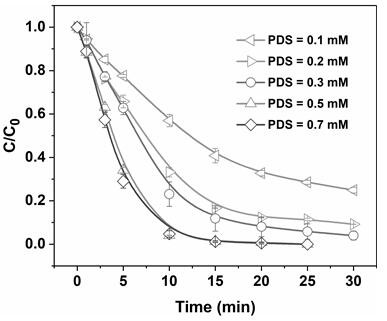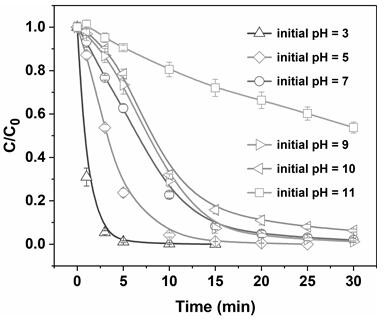Method for degrading organic matters in water by synergistically activating permanganate-persulfate through cathode and anode
A technology of permanganate and persulfate, applied in chemical instruments and methods, water pollutants, water/sewage treatment, etc., can solve the problems of small scope of application, low activation efficiency, secondary pollution, etc., and achieve low prices. , Improve the treatment effect, the effect of enhanced reactivity
- Summary
- Abstract
- Description
- Claims
- Application Information
AI Technical Summary
Problems solved by technology
Method used
Image
Examples
Embodiment 1
[0047]Prepare diclofenac solution with a concentration of 40 μM, take 200mL diclofenac solution into five clean 250mL beakers, and inject it into the reaction chamber containing the negative / positive electrode system (electrode material is titanium-plated platinum electrode), and then pour into each reaction chamber Sodium persulfate was added to make the concentration of sodium persulfate reach 0.5mM. At the same time, potassium permanganate was added to each reaction chamber to make the concentration of potassium permanganate reach 0.02mM, 0.04mM, 0.08mM, respectively. 0.10mM and 0.12mM. Turn on the power switch and adjust the current to 200mA. Stir at room temperature at a speed of 800rpm for 30min, take 1mL samples at regular intervals for analysis, the results are as follows figure 1 shown.
[0048] As can be seen from the figure, when the concentration of potassium permanganate (PM) is in the range of 0.02 to 0.12mM, with the increase of the concentration of potassium ...
Embodiment 2
[0050] The test procedure is the same as in Example 1, wherein the concentration of potassium permanganate in each diclofenac solution is 0.1 mM, and the concentration of sodium persulfate (PDS) is 0.1 mM, 0.2 mM, 0.3 mM, 0.5 mM and 0.7 mM respectively. The result is as figure 2 shown.
[0051] It can be seen from the figure that when the concentration of sodium persulfate is greater than 0.2mM, the degradation rate of the system of the present invention to diclofenac can reach more than 90%. It can be seen that for low-concentration micro-polluted wastewater, the concentration of sodium persulfate can be selected from 0.01 to 0.7mM. As the concentration of organic matter in wastewater increases, the concentration of potassium permanganate needs to increase accordingly, and the concentration of sodium persulfate can be selected From 0.01 to 1000mM.
Embodiment 3
[0053] The test procedure is the same as in Example 1, wherein the concentration of potassium permanganate in each diclofenac solution is 0.1 mM, and the solution is added with sodium hydroxide or concentrated sulfuric acid solution to adjust the initial pH to 3, 5, 7, 9, 10 and 11 respectively, and the results Such as image 3 shown.
[0054] It can be seen from the figure that under the condition that the initial pH of the solution is 3-10, the degradation rate of the system of the present invention for diclofenac can reach more than 90%.
PUM
 Login to View More
Login to View More Abstract
Description
Claims
Application Information
 Login to View More
Login to View More - R&D
- Intellectual Property
- Life Sciences
- Materials
- Tech Scout
- Unparalleled Data Quality
- Higher Quality Content
- 60% Fewer Hallucinations
Browse by: Latest US Patents, China's latest patents, Technical Efficacy Thesaurus, Application Domain, Technology Topic, Popular Technical Reports.
© 2025 PatSnap. All rights reserved.Legal|Privacy policy|Modern Slavery Act Transparency Statement|Sitemap|About US| Contact US: help@patsnap.com



